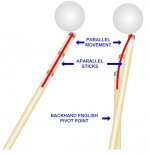If the cue tip hits the CB on the same point, from the same angle and at the same speed, does changing only the cue stick's orientation with "swooping" backhand english change the amount of squirt?

I'm thinking that if the cue is angled toward the CB's center compared with the tip's direction of travel, then its effective endmass increases, creating more squirt. Anybody know?
pj
chgo

I'm thinking that if the cue is angled toward the CB's center compared with the tip's direction of travel, then its effective endmass increases, creating more squirt. Anybody know?
pj
chgo
Last edited: